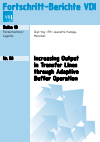Increasing Output in Transfer Lines through Adaptive Buffer Operation
Zusammenfassung
This thesis is intended for engineers and scientists in the field of production. It deals with the goal of increasing output in (serial) transfer lines and simultaneously decreasing labor costs without need of change to the structure of the production system. For this the method adaptive buffer operation is developed, implemented and validated. Adaptive buffer operation proposes a different way of operating buffers, improving the decoupling effect of buffers. The buffers are filled to certain target fill levels at fixed moments (times of the day). Apart from the target fill levels further parameters, e.g. moments of intervention or the intervention frequency, are identified. To find out how to operate the buffers and which parameter combinations work best, a simulation-based optimization method is proposed. This method is split into the evaluative methodology, here simulation, and the generative technique of evolution strategies, solving the multi-objective optimization problem. Proo...
Schlagworte
- I–XIV
- 1–6 1 Introduction 1–6
- 1.1 Background and motivation of research
- 1.2 General objective
- 1.3 Structure of this dissertation
- 7–38 2 Buffer management in manufacturing systems 7–38
- 2.1 Fundamentals in manufacturing
- 2.2 Evaluative solution methodology in manufacturing systems optimization
- 2.2.1 Simulation
- 2.2.2 Decomposition
- 2.2.3 Design of Experiments
- 2.3 Generative solution methodology
- 2.3.1 Fundamentals in optimization
- 2.3.2 Optimization methods
- 2.3.3 Evolutionary Algorithms
- 2.4 Requirements of a solution method to increase output
- 2.4.1 System-oriented requirements to the solution method
- 2.4.2 Application-oriented requirements
- 2.4.3 Summary of requirements
- 2.5 Analysis of relevant approaches
- 2.5.1 Buffer allocation problem
- 2.5.2 Optimal production control: the hedging point policy
- 2.6 Assessment of existing approaches and need for further research
- 39–63 3 Method design for increased output in assembly 39–63
- 3.1 General outline of method for increasing output
- 3.2 Assumptions and notations
- 3.3 Adaptive buffer operation: method description and its parameters
- 3.3.1 Buffer filling policy
- 3.3.2 Target fill level
- 3.3.3 Moments of intervention
- 3.3.4 Variable intervention parameters
- 3.3.5 Conclusion and identified intervention parameters
- 3.4 Buffer filling algorithms
- 3.4.1 Simplified example: two machine transfer line
- 3.4.2 ܯ݊ 1 machine transfer line
- 3.4.3 Calculation of time to stop before end of production
- 3.5 Simulation-based method used for optimization
- 3.5.1 Performance indicators to be monitored
- 3.5.2 Optimization concept
- 3.5.3 Evolutionary Algorithms used for search of solutions
- 3.6 Implementation of the simulation-based solution method
- 64–96 4 Application of method 64–96
- 4.1 Model building
- 4.1.1 Conceptual model
- 4.1.2 Data collection and processing
- 4.1.3 Verification and validation (V&V) of model
- 4.1.4 Number of replications and run-length
- 4.2 Experiments
- 4.2.1 Single-objective optimization: minimize manufacturing cost per unit
- 4.2.2 Single-objective optimization: maximize output
- 4.2.3 Multi-objective optimization
- 4.2.4 Further experimentation
- 4.2.5 Conclusion of results and findings
- 4.3 Concluding assessment and discussion
- 97–99 5 Summary and outlook 97–99
- 100–102 A Results single-objective optimization 100–102
- 103–110 B Results multi-objective optimization 103–110
- 111–113 C Results further experiments 111–113
- 114–117 D Validation of simulation 114–117
- 118–132 References 118–132


